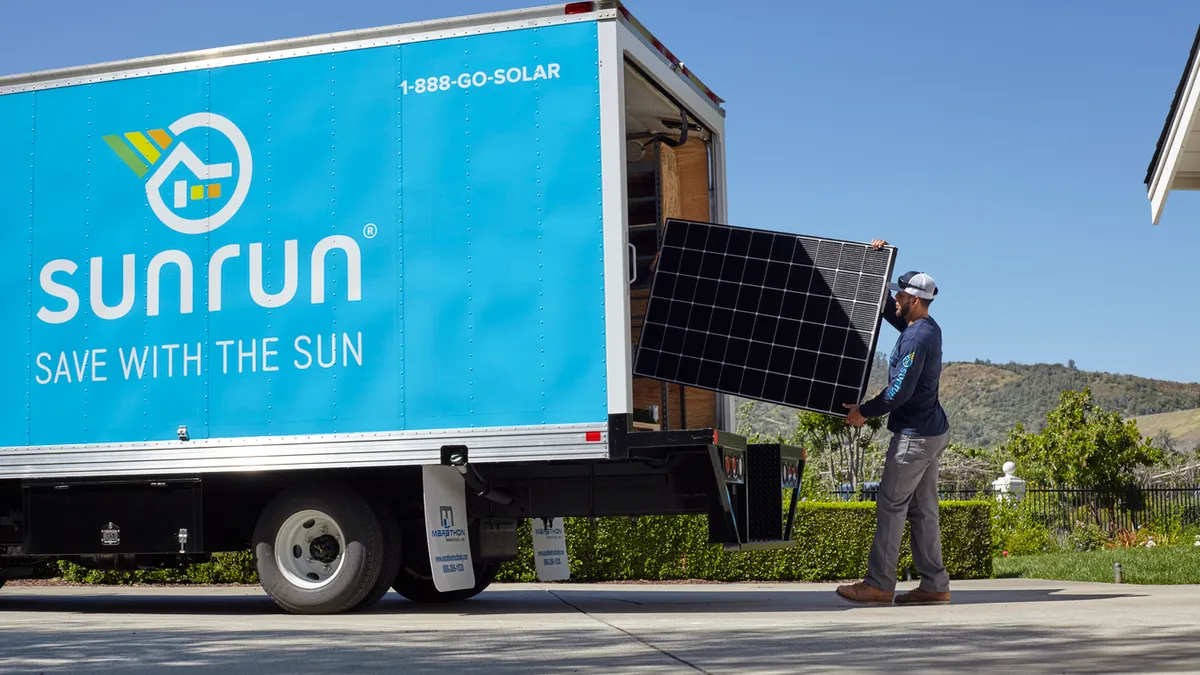Dive Brief:
- Southern California Edison (SCE) announced on Tuesday a program that will allow up to 300 customers to create a distributed solar-plus-storage network through Sunrun's Brightbox home energy system that the utility can call on over the next year during peak demand times.
- The virtual power plant has an undisclosed potential capacity and is an SCE pilot program, after which similar offerings could be made with other solar and storage providers, Jessica Lim, SCE principal manager of product management, told Utility Dive. Sunrun, which is in talks with other utilities for similar bring-your-own-device (BYOD) offerings, hopes the one year trial is the first phase of many in the partnership with SCE, Anne Hoskins, Sunrun's chief policy officer, told Utility Dive.
- Sunrun is currently enrolling its existing Brightbox customers into the program and expects to "start offering the benefits of this virtual power plant" very quickly, Hoskins said. SCE customers participating are not expected to see a difference in how their behind-the-meter system operates and will receive a $250 incentive at the end of the first year.
Dive Insight:
SCE aims to address multiple problems through this program, including encouraging customer adoption of solar-plus-storage. The utility's "Pathway 2045" goals for carbon neutrality require 110 GW of solar and 40 GW of storage to be added by the utility — including 30 GW of solar and 10 GW of storage on the customer-side alone.
"[I]f this is the program that could help influence and [incentivize] our customers to work with a utility," and provide self-generated power to the grid, the partnership will lead to "a new way of working with customers that we're looking forward to in terms of helping us to be carbon neutral by 2045," said Lim, who focuses on distributed energy at the utility.
As of May, the utility has had over 8,000 installations of customer-sited storage, largely in residential areas, a major uptick from the 116 customer-sited storage installations in 2015. Those systems represent 81 kW/180 kWh and the utility expects 1,600 MW by 2030. Sunrun is the largest rooftop solar and storage supplier in SCE's service territory, prompting the creation of the partnership to meet growing customer demand.
Other utilities, including Liberty Utilities in New Hampshire and Green Mountain Power (GMP) in Vermont, have also created BYOD programs with energy storage that can be used for demand response, offering tariffs that compensate customers when they have a battery installed. Both utilities initially involved Tesla Powerwall systems in their pilots.
"What's different here is we don't have a tariff in California" to reward customers when utilities use behind-the-meter energy storage, Hoskins said. "That would be something that [California regulators] could consider. This has gone through an arrangement with a direct agreement with [SCE]."
As with previous BYOD programs, future iterations could involve more competition.
New England utility offerings for BYOD solar-plus-storage programs have continued under pressure from distributed services providers to support competition in the residential energy market. GMP and Liberty both included competition in later phases of their projects.
SCE will determine next steps at the conclusion of the 12-month pilot, Lim said. "We could open it up to the market and go from there ... or it could also morph into another program."
The utility wants to encourage customer interest in self-generation as a potential way to mitigate power outages during the wildfire season.
SCE is considering "how can we partner with our customers to help with clean energy and with our grid optimization, which could include microgrids in the future," Lim said. And part of that includes providing solutions for backup power in high fire risk areas, she added.
California incentives already exist for income-qualified residents to add energy storage in high fire risk areas, known as the Self-Generation Incentive Program.
SCE's pilot is an opportunity to "learn what it would take to leverage our customers to see if we could take advantage of the energy that they're producing," Lim said.
"We're really testing for responsiveness in delivering energy. We're also looking to see whether we achieve the energy delivered as expected, and then we're testing our overall operational process," Lim said, with a third party evaluating the results from different scenarios.
The focus will mainly be on providing relief to the system by using customer-sited storage during on-peak time, between 4 p.m. and 9 p.m., she said, in addition to other test scenarios such as severe weather conditions.
Other utilities could follow suit with a program that encourages customers to add distributed resources, Hoskins said. In California, Sunrun's largest state market, the company has submitted a conference paper and additional information to Los Angeles Department of Water and Power (LADWP) proposing a BYOD program in its region.
"We saw that there was enough potential in the LADWP territory" to reduce one of three gas-fired generation plants that Mayor Eric Garcetti plans to replace, Hoskins said.
As of discussions last year among the investor-owned utilities, Lim said Pacific Gas & Electric and San Diego Gas & Electric did not have programs using distributed systems as a virtual power plant. PG&E and SDG&E did not respond in time for publication.
"Hopefully it will become a model, maybe we can make it more broadly available across California," Hoskins said.















